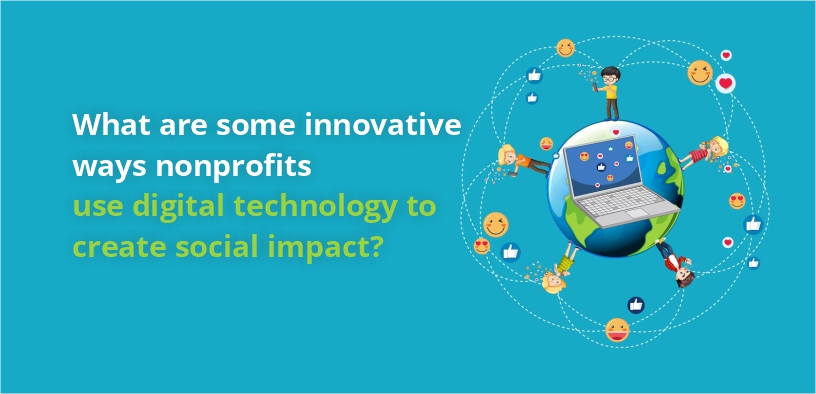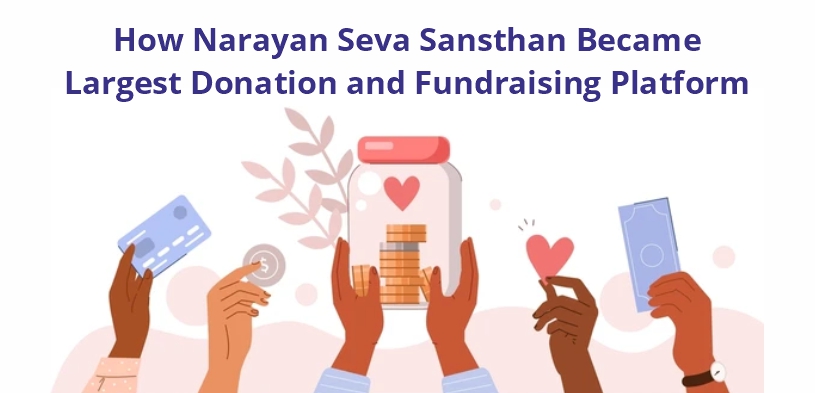In today’s digital age, nonprofit organizations & NGOs are leveraging technology to transform the way they address societal challenges and create positive social impact. One such pioneering organization that has been at the forefront of using digital technology to uplift the lives of people in need is Narayan Sewa Sansthan.
1: Online Fundraising and Donor Engagement
Digital technology has transformed the landscape of fundraising for nonprofit organizations. Here are some innovative approaches:
Crowdfunding Campaigns: Nonprofit organizations leverage crowdfunding platforms to raise funds for specific projects or urgent causes. These campaigns enable individuals worldwide to contribute small amounts, collectively making a significant impact.
Peer-to-Peer Fundraising: Nonprofit organizations engage supporters to create personalized fundraising pages, encouraging their network to donate, and expanding the organization’s reach exponentially.
Blockchain for Transparent Donations: Some nonprofits use blockchain technology to ensure transparency in donation tracking. This builds trust among donors, as they can trace their contributions’ utilization and impact.
2: Data-Driven Decision Making
Data-driven insights are crucial for nonprofits to understand the scope and depth of social issues they aim to address. Digital technology facilitates this process:
Big Data Analytics: Nonprofits analyze large datasets from various sources to identify patterns, trends, and correlations. This allows for more informed decision-making and targeted interventions.
AI-Driven Predictive Models: Artificial Intelligence (AI) and machine learning algorithms help nonprofits predict potential challenges and design proactive solutions to address them effectively.
Impact Measurement Tools: Digital platforms provide tools to measure the social impact of nonprofit initiatives accurately. These metrics help in assessing progress, refining strategies, and demonstrating accountability to stakeholders.
3: Social Media for Advocacy and Awareness
Social media platforms have become powerful tools for nonprofits to raise awareness and advocate for social causes:
Viral Campaigns: Nonprofits create compelling content, videos, or challenges that have the potential to go viral, rapidly spreading their message to a vast audience.
Influencer Partnerships: Collaborating with social media influencers allows nonprofits to reach diverse audiences and engage with demographics they might not otherwise access.
Online Petitions and Advocacy: Nonprofits use digital platforms to gather support for various causes through online petitions, encouraging individuals to be part of collective action for change.
4: E-Learning and Skill Development
Digital technology has revolutionized education and skill development programs for social impact:
Online Education Platforms: Nonprofits offer free online courses and educational resources to empower marginalized communities and enhance their employability.
Virtual Mentorship: Digital platforms enable remote mentorship programs, connecting individuals in need with experienced professionals who can guide and inspire them.
Skill-Building Apps: Nonprofits develop interactive mobile applications to teach vocational skills, such as farming techniques or craftsmanship, to underserved populations.
5: Digital Health Initiatives
Nonprofits leverage digital technology to improve healthcare access and deliver vital medical services:
Telemedicine and Remote Healthcare: Nonprofits employ telemedicine to connect healthcare professionals with remote or underserved communities, providing expert medical advice and diagnoses.
Mobile Health (mHealth) Solutions: Nonprofits develop mobile apps to promote health awareness, track diseases, and deliver health-related information to vulnerable populations.
Wearable Devices for Data Collection: Nonprofits utilize wearable devices and health trackers to collect data for medical research and public health initiatives.
6: Virtual Reality (VR) and Immersive Experiences
Nonprofits have embraced virtual reality (VR) technology to enhance their advocacy efforts and create empathy-driven experiences:
Immersive Storytelling: Nonprofits use VR to tell compelling stories and transport audiences to the heart of social issues. This immersive approach generates greater empathy and understanding, encouraging people to take action.
Awareness Campaigns: VR experiences are employed to raise awareness about pressing global challenges, such as climate change, refugee crises, or poverty, by allowing viewers to witness the realities faced by affected communities.
Training and Empathy Building: Nonprofits use VR simulations to train staff and volunteers in challenging environments or simulate experiences faced by the communities they serve, fostering empathy and cultural understanding.
7: Collaborative Platforms and Open Source Initiatives
Digital technology enables nonprofits to collaborate and share resources effectively:
Collaborative Platforms: Nonprofits leverage collaborative platforms and project management tools to work seamlessly with distributed teams, volunteers, and partner organizations, maximizing productivity and coordination.
Open Source Software: Some nonprofits develop and contribute to open source software solutions that address common challenges faced by the social sector, fostering innovation and shared learning.
Data Sharing and Knowledge Exchange: Nonprofits participate in data-sharing initiatives and knowledge exchange platforms, allowing them to learn from each other’s experiences and collectively improve social impact strategies.
8: Virtual Events and Conferences
Digital technology has revolutionized the way nonprofits host events and engage their stakeholders:
Virtual Conferences: Nonprofits organize virtual conferences and webinars, enabling participants from diverse locations to attend, reducing costs, and minimizing the environmental impact associated with physical events.
Online Workshops and Training: Nonprofits offer online workshops and training sessions to empower their beneficiaries and volunteers with new skills, irrespective of geographical barriers.
Virtual Fundraisers: Nonprofits organize virtual fundraising events, such as online auctions, virtual galas, and live-streamed concerts, to engage donors and raise funds for their initiatives.
9: AI-Powered Chatbots and Support Services
AI-driven chatbots have become valuable resources for nonprofits in providing support and assistance:
24/7 Support: Nonprofits deploy AI-powered chatbots on their websites and social media channels to offer round-the-clock assistance to beneficiaries and donors, answering FAQs and providing real-time support.
Mental Health Support: Some nonprofits use chatbots equipped with natural language processing to offer mental health support and crisis intervention to individuals in need.
Language Access: AI chatbots can be programmed to communicate in multiple languages, ensuring language barriers do not hinder access to crucial information and support.
Conclusion
Innovative ways of using digital technology are revolutionizing the landscape of social impact initiatives. Narayan Sewa Sansthan’s adoption of telemedicine, mobile applications, social media campaigns, virtual reality experiences, and data analytics showcases how digital technology can be harnessed to create lasting positive change in the lives of people with disabilities.
These approaches not only improve access to crucial services but also empower individuals to lead more independent and fulfilling lives. As technology continues to evolve, nonprofits must remain adaptable and open to exploring new avenues for leveraging digital tools to achieve their mission of creating a more inclusive and compassionate society.








